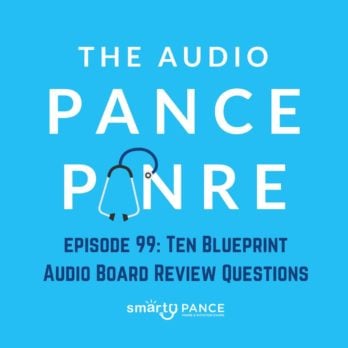Podcast Episode 99: Ten PANCE, PANRE, and Rotation Review Questions
Description
 Welcome to episode 99 of the Audio PANCE and PANRE Physician Assistant/Associate Board Review Podcast.
Welcome to episode 99 of the Audio PANCE and PANRE Physician Assistant/Associate Board Review Podcast.
Join me as I cover ten PANCE, PANRE, and EOR™ review questions from the Smarty PANCE Instagram/Facebook page and the smartypance.com board review website.
Special from today’s episode:
- Join the Smarty PANCE Member’s Community
- Check out our all-new End of Curriculum™ (EOC) Exam Course (still in development)
- Follow Smarty PANCE and The Daily PANCE Blueprint on Instagram
- Follow Smarty PANCE and The Daily PANCE Blueprint on Facebook
Below you will find an interactive exam to complement today’s podcast.
The Audio PANCE/PANRE and EOR PA Board Review Podcast
I hope you enjoy this free audio component to the examination portion of this site. The full board review course includes over 2,000 interactive board review questions and is available to all members of Smarty PANCE.
- You can download and listen to past FREE episodes here, on iTunes, Spotify, Google Podcasts, Stitcher, and most podcasting apps.
- You can listen to the latest episode, take an interactive quiz, and download more resources below.
Listen Carefully Then Take the Practice Exam
If you can’t see the audio player, click here to listen to the full episode.
Podcast Episode 99: Ten PANCE/PANRE and EOR Topic Blueprint Questions
1. A 42-year-old male on lithium presents with polyuria, nocturia, and polydipsia. Laboratory findings are remarkable for slightly elevated sodium. Which of the following is the most likely diagnosis?
A. Neurogenic diabetes insipidus
B. Nephrogenic diabetes insipidus
C. Type 2 diabetes mellitus
D. SIADH
E. Adrenal insufficiency
The answer is B. Nephrogenic diabetes insipidus
Nephrogenic diabetes insipidus (DI) is a condition where the kidneys are resistant to the effects of ADH. Nephrogenic DI can occur secondary to lithium toxicity or chronic lithium use, pregnancy, inherited disorders, and electrolyte issues. Clinical features include polyuria, nocturia, and polydipsia. Serum sodium is either normal or high.
In this patient, lithium has entered the collecting duct, accumulated, and interfered with ADH’s capacity to increase water permeability. Treatment options for this patient include amiloride or thiazide diuretics. In general, whether or not lithium is discontinued depends on many factors.
Smarty PANCE Content Blueprint Review:
Covered under ⇒ PANCE Blueprint Endocrinology ⇒ Pituitary Disorders ⇒ Diabetes insipidus
Also covered as part of the Internal Medicine EOR and Emergency Medicine PAEA EOR topic list
2. A 50-year-old female presents with poor appetite, low energy, poor concentration, and feelings of hopelessness on most days for the past 3 years. She denies suicidal ideation. She has never had a past manic or hypomanic episode. Which of the following is the best treatment option?
A. Haloperidol
B. Fluoxetine
C. Lorazepam
D. Amitriptyline
E. Risperidone
The answer is B. Fluoxetine
This patient has dysthymia, or persistent depressive disorder. The DSM V criteria follow:
- Depressed mood ≥ 2 years on most days
- At least 2 of the following: appetite changes, sleep changes, low energy, low self-esteem, poor concentration, hopelessness
- Not without symptoms > 2 months at a time
- No mania or hypomania episodes, ever
Like other psychiatric disorders, symptoms can’t be attributable to drugs, and the symptoms must cause distress/impairment. 1st line treatment is selective serotonin reuptake inhibitors and psychotherapy.
Smarty PANCE Content Blueprint Review:
Covered under ⇒ PANCE Blueprint Psychiatry ⇒ Depressive disorders ⇒ Persistent depressive disorder (dysthymia)
Also covered as part of the Psychiatry EOR, Emergency Medicine EOR, and Pediatric PAEA EOR topic list
3. An 85-year-old male with a history of chronic kidney disease presents to the ER with muscle cramps. Laboratory studies reveal potassium of 7.8 mEq/L. EKG reveals peaked T waves. Which of the following is the best initial med to give?
A. Insulin
B. Albuterol
C. Furosemide
D. Sodium bicarbonate
E. Calcium gluconate
The answer is E. Calcium gluconate
Hyperkalemia is caused by many things: iatrogenic (ACEI/ARBs), cellular destruction (hemolysis, tumor lysis syndrome, burns), renal failure, adrenal insufficiency, etc. Symptoms are nonspecific and include muscle weakness, N/V, decreased DTRs, etc. Classically on EKG, you may see peaked T waves (there are many other findings though…such as QRS widening, PR interval prolongation, sine-wave, etc). Management for severe hyperkalemia includes calcium gluconate (stabilizes the resting membrane potential of the myocardial membrane), shifting potassium intracellularly (via beta-agonists, sodium bicarbonate, insulin), and removing potassium (via diuretics, kayexalate, or hemodialysis).
Smarty PANCE Content Blueprint Review:
Covered under ⇒ PANCE Bluepr







